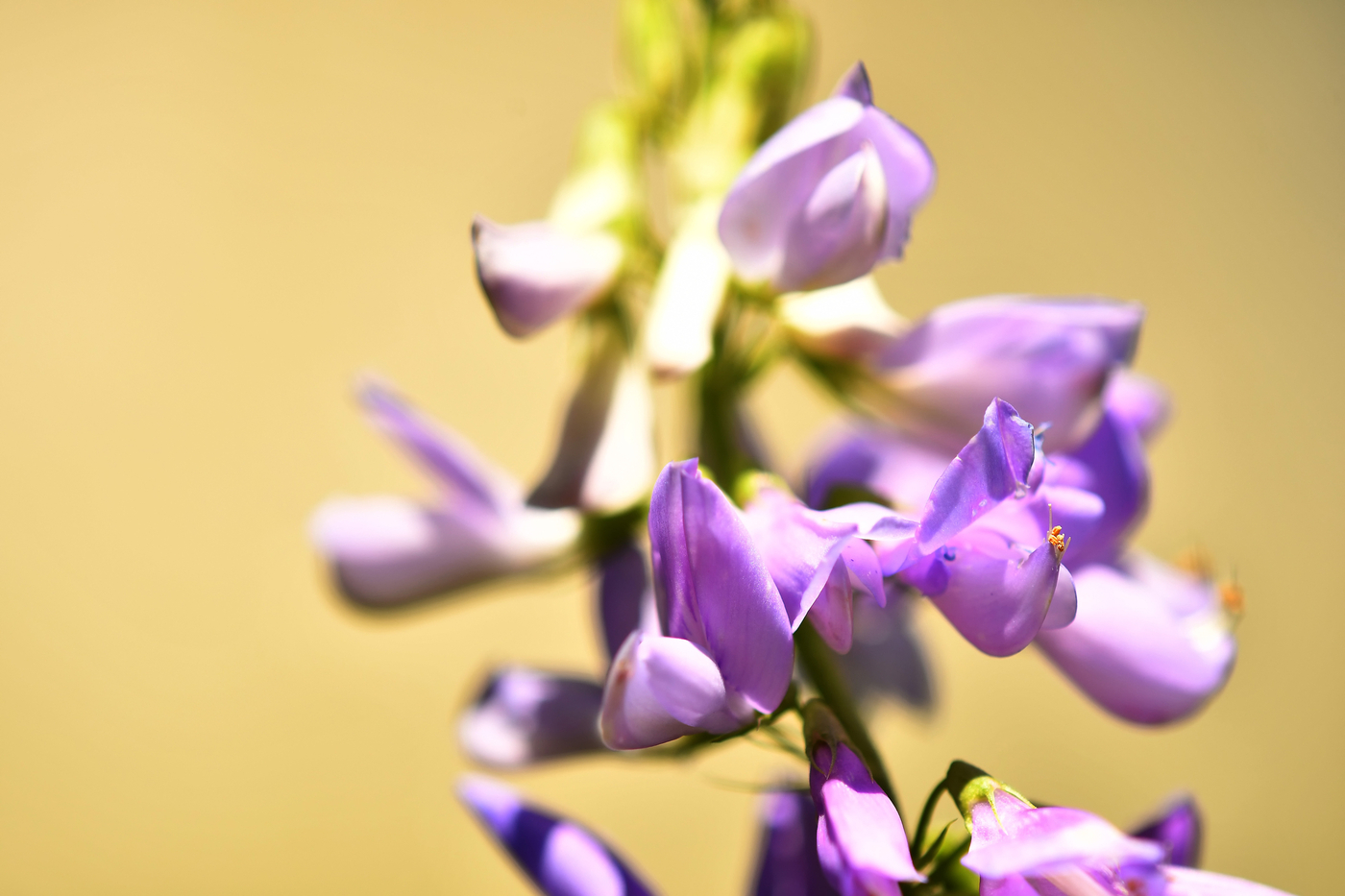There are tons of flowers, and while you may know a lot of them, some on this list might surprise you. To keep things simple, we’ve created a list of 29 types of flowers that start with G. With that, let’s jump right in!
List of Flowers that Start with the Letter G
- Gaillardia (Gaillardia x Grandiflora)
- Gardenia (Gardenia jasminoides)
- Geranium (Pelargonium spp.)
- Gerbera daisy (Gerbera jamesonii)
- Globe Amaranth (Gomphrena globosa)
- Gloxinia (Sinningia speciosa)
- Gypsophila spp. (Baby’s Breath)
- Galanthus nivalis (Snowdrop)
- Gas plant (Dictamnus albus)
- Gaura lindheimeri (Wand flower)
- Gayfeather (Liatris spp.)
- Gazania (Gazania rigens)
- Gentian (Gentiana spp.)
- Geranium maculatum (Wild geranium)
- Germander (Teucrium spp.)
- Geum spp. (Avens)
- Giant barrel cactus (Echinocactus platyacanthus)
- Giant fleece flower (Persicaria polymorpha)
- Giant hyssop (Agastache spp.)
- Gladiolus (Gladiolus palustris)
- Globeflower (Trollius spp.)
- Globe thistle (Echinops spp.)
- Goatsbeard (Aruncus spp.)
- Godetia (Clarkia amoena)
- Golden groundsel (Senecio aureus)
- Goldenrod (Solidago spp.)
- Gooseneck loosestrife (Lysimachia clethroides)
- Grape hyacinth (Muscari armeniacum)
- Gumamela (Hibiscus rosa-sinensis)
Annual Flowers that Start with G
Gaillardia (Gaillardia x Grandiflora)
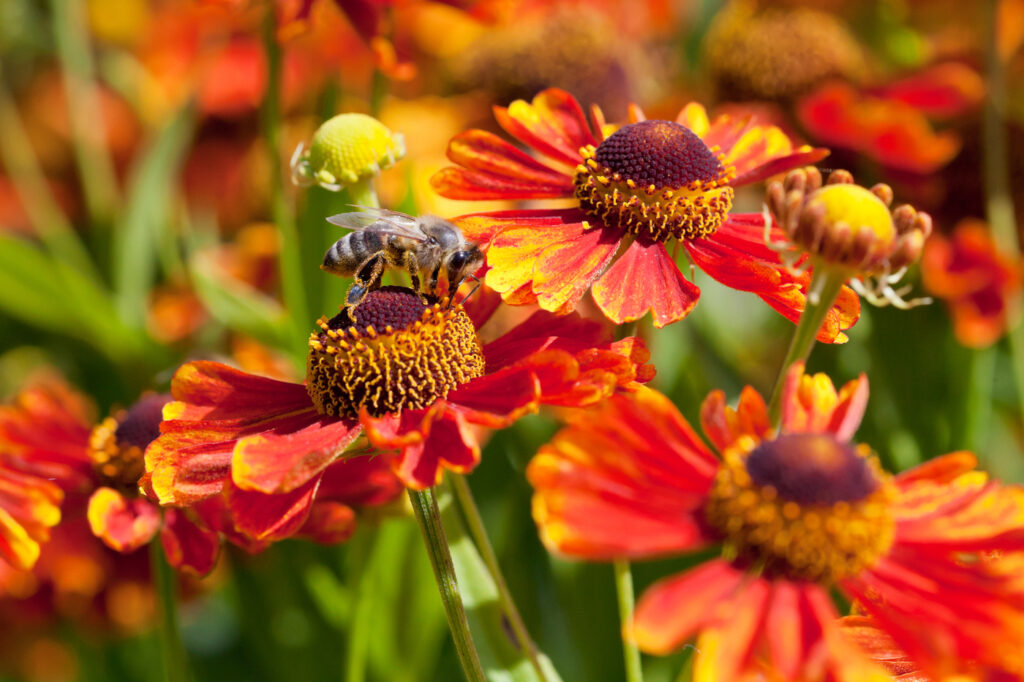
Gaillardia is part of the daisy family, Asteraceae which is native to the Americas. While botanists consider this a short-lived perennial, many gardeners grow it as an annual. It thrives in full sun and grows to be just over a foot tall. It blankets the ground in brilliant color, hence the name!
Gardenia (Gardenia jasminoides)
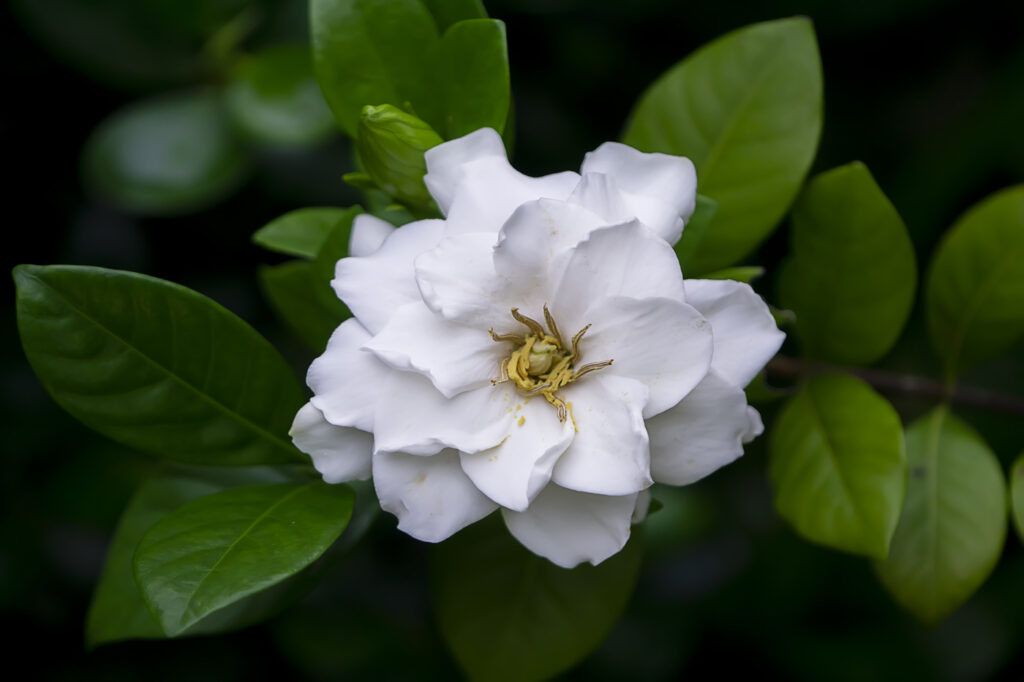
The gardenia is one of the most iconic flowers that start with G. It’s a shrub that blooms with fragrant white rose-like flowers. This hard-to-grow shrub can grow outdoors, but only in ideal conditions. It’s considered an annual in most zones. Most gardeners prefer to grow them indoors because they are native to tropical regions.
Geranium (Pelargonium spp.)
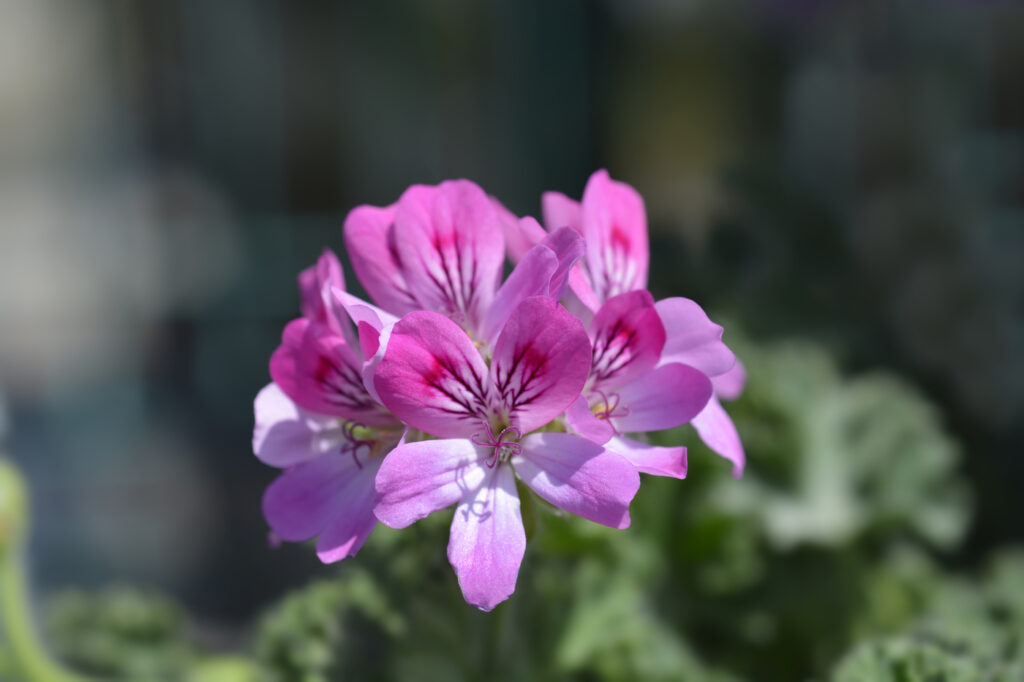
This flower is not truly a geranium, rather it’s a pelargonium! It was erroneously dubbed “geranium” because the flowers bore a resemblance to wild geranium.
Pelargoniums are native to south Africa and can be grown in part sun or part shade. To keep the flower alive year-round, overwinter it indoors or take cuttings to regrow in spring.
Gerbera daisy (Gerbera jamesonii)
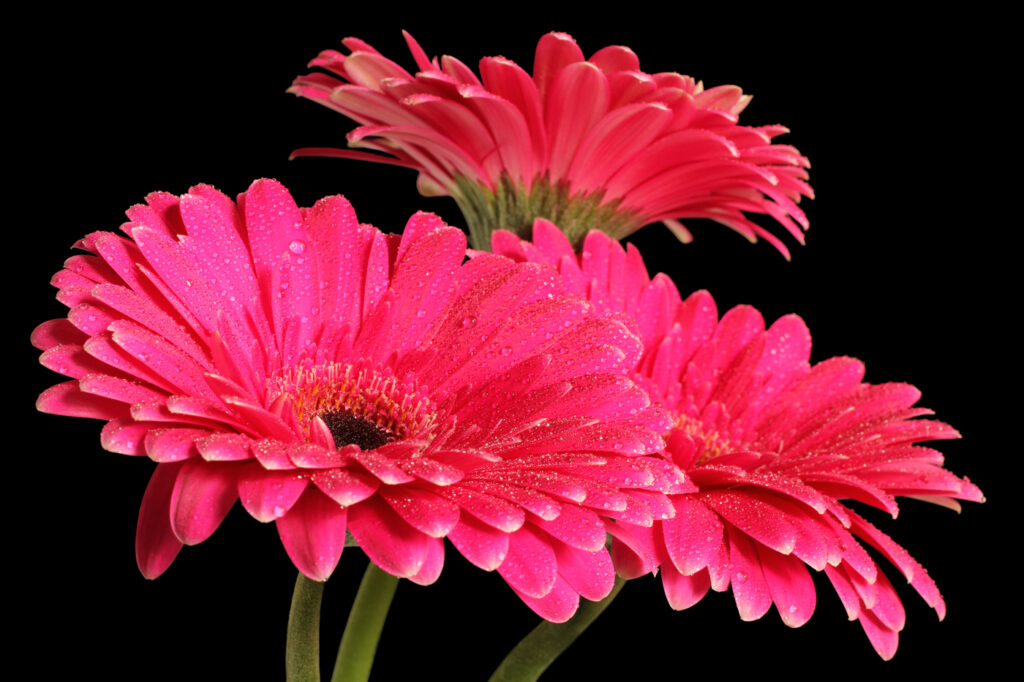
Also native to South Africa, the Gerbera daisy can be grown indoors or outdoors as an annual. Florists like them for their bold colors and long-lasting flowers. They grow well in sunny spots indoors or in part shade outdoors. But be careful not to overwater, this flower is prone to root rot.
Globe Amaranth (Gomphrena globosa)
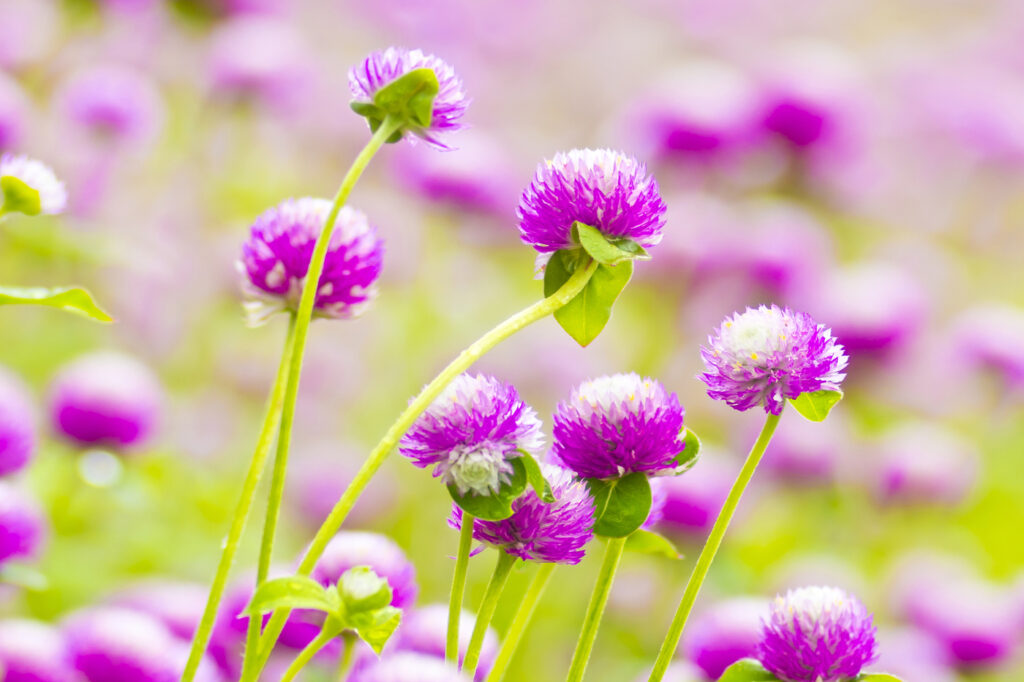
This tropical native from central America blooms all summer. It shows off sprays of pink, red, purple, and white globe-like flowers. The beautiful colors are from the bracts, not the flowers. It grows up to two feet tall and makes a colorful addition to any garden.
Gloxinia (Sinningia speciosa)
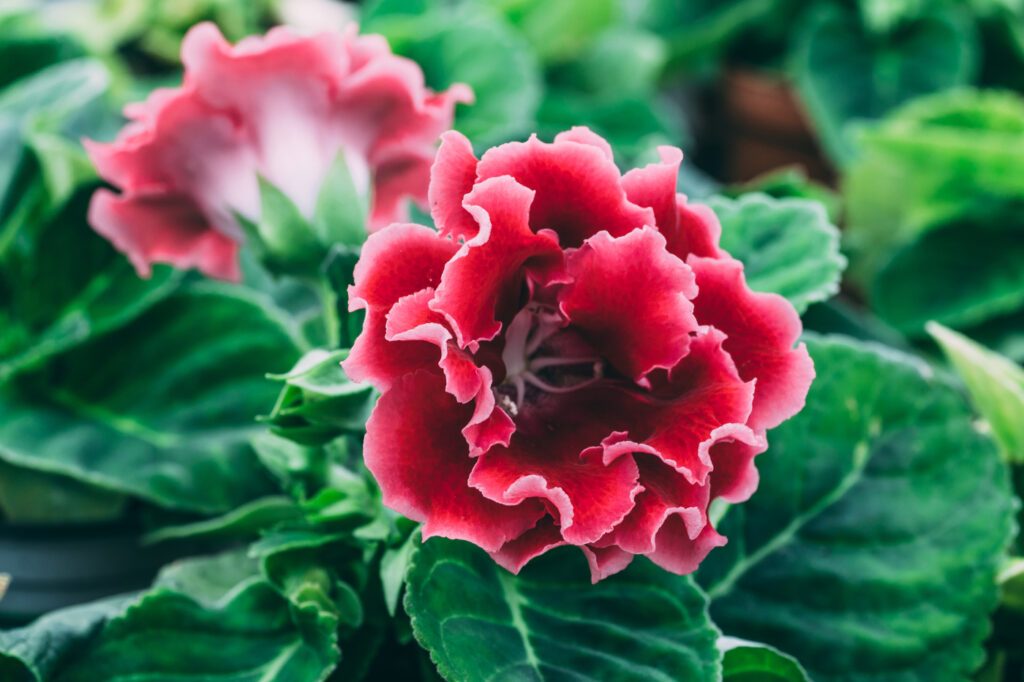
Also known as the African violet, gloxinia is usually grown as an indoor plant. This plant has velvety, vibrant flowers and it needs a dormancy period to rebloom. It’s a notoriously sensitive plant that hates cold water on its leaves.
Gypsophilia spp. (Baby’s Breath)
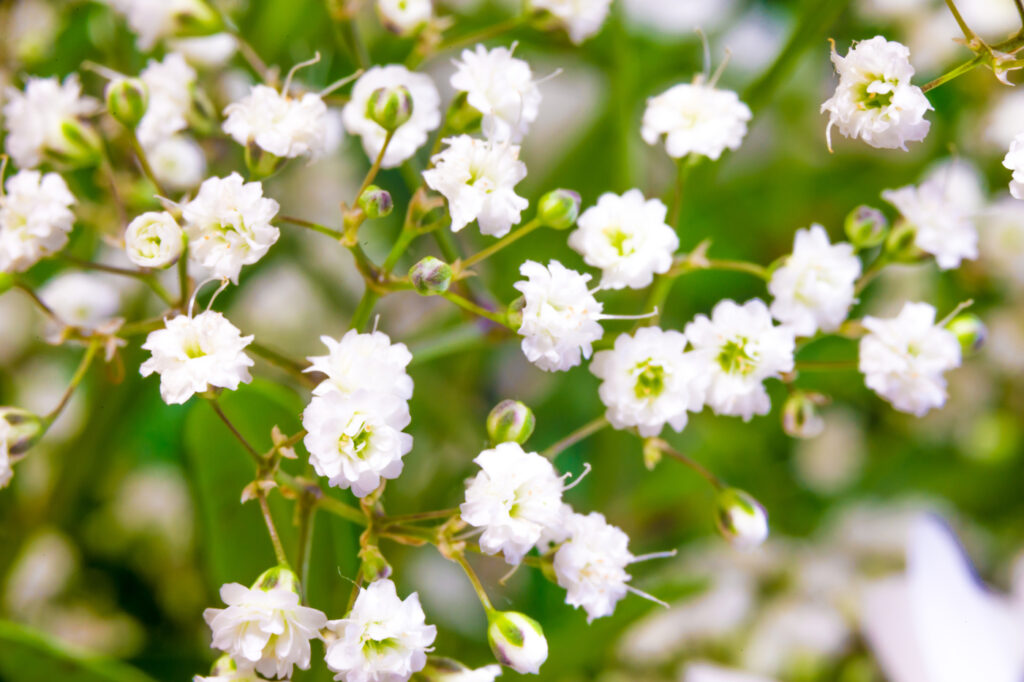
Some species of baby’s breath are perennial in Zones three to nine. However, most varieties are annuals. The plant’s multitude of white or pink flowers grow in mounds and is native to Europe and Asia. Some states classify baby’s breath as an invasive weed, so plant with caution!
Perennial Flowers that Start with a G
Galanthus nivalis (Snowdrop)
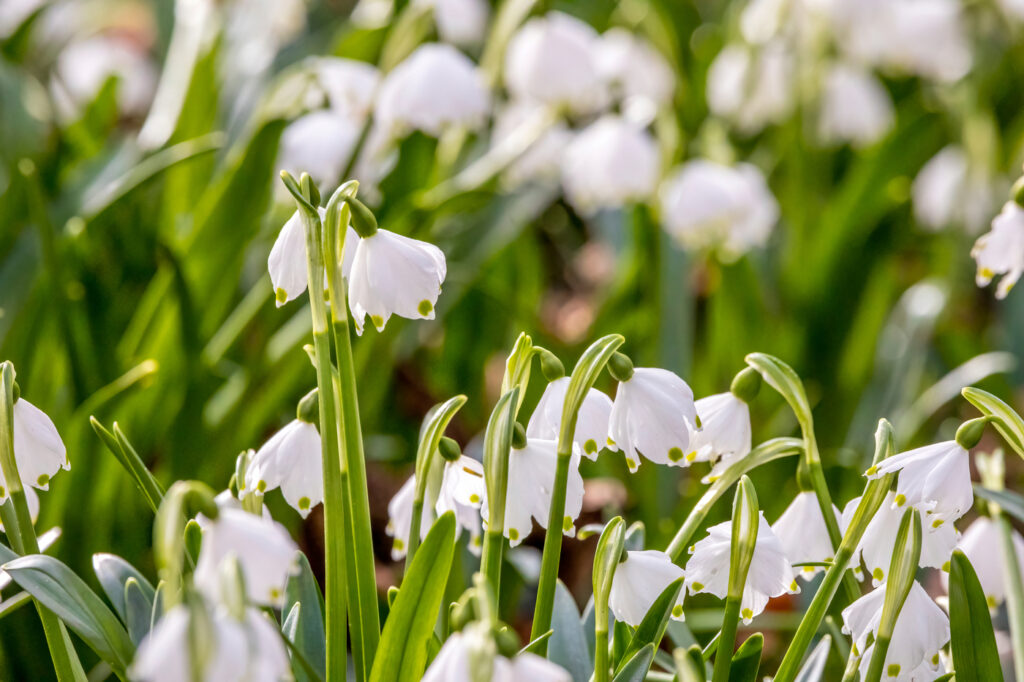
Galanthus is a bulb flower that has gained popularity over the last few years, and for good reason. Gardeners know spring has officially begun when they spot the tiny, white flowers. They grow best in Zones three to nine and in well-draining soil.
Gas plant (Dictamnus albus)
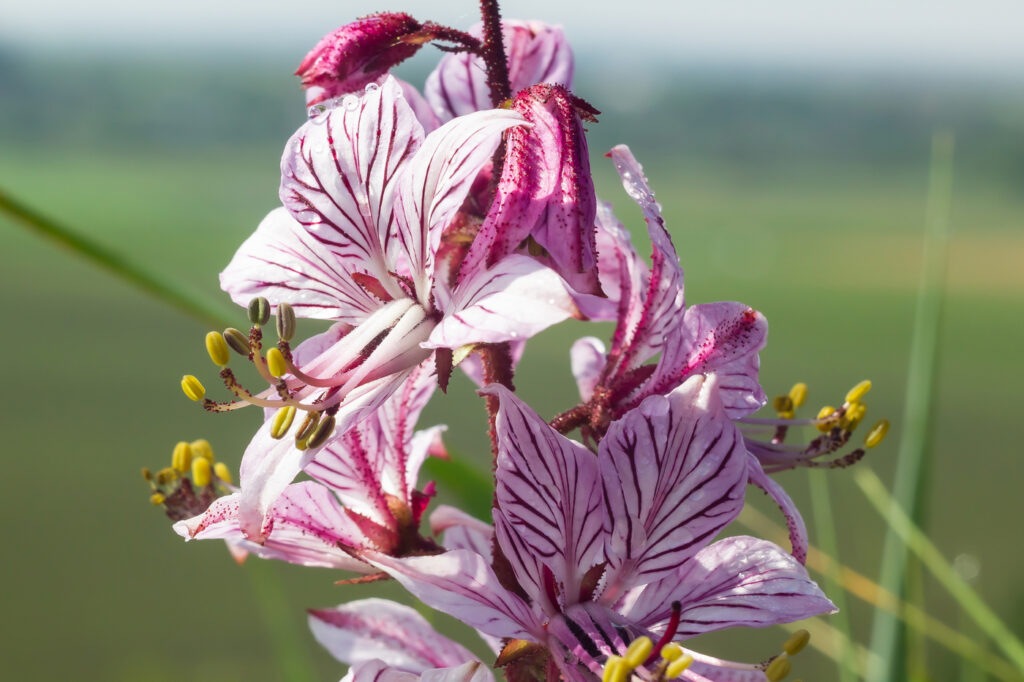
A native to Europe, the gas plant has white, spidery flowers. It’s a herbaceous perennial that grows in Zones three to nine. When its seedpods dry in hot weather, they will emit a gas that’s flammable. That’s where it gets the name!
Gaura lindheimeri (Wand flower)
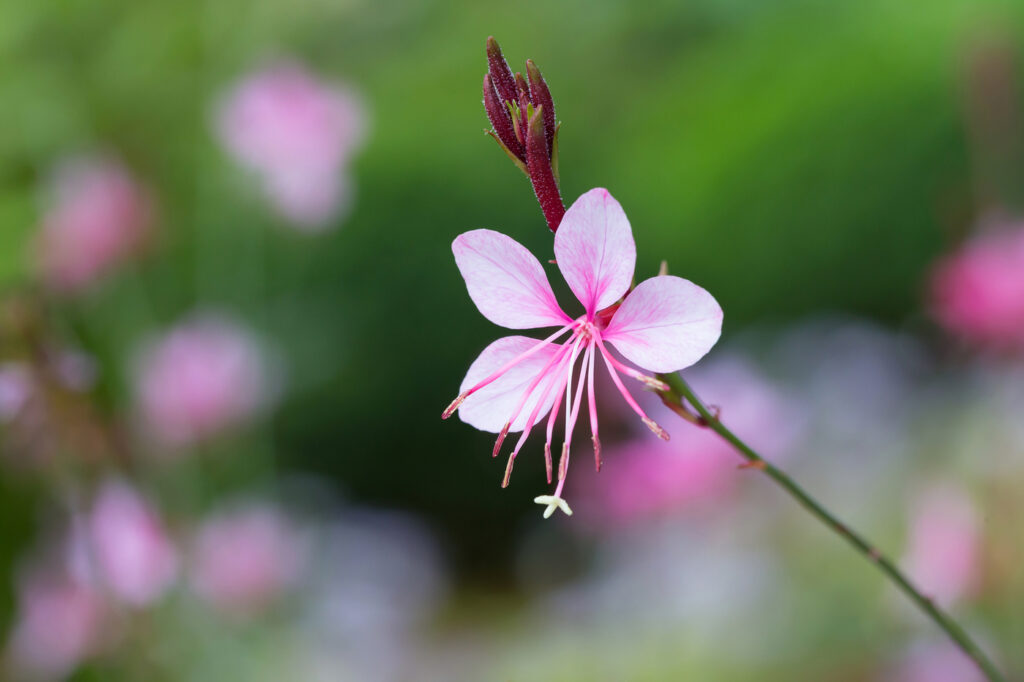
The gaura is a late-summer bloomer that can grow up to five feet tall. This shrub displays white, sprawling flowers making it an excellent cottage garden plant. It’s native to the Southeastern U.S. and parts of Mexico. It grows best in Zones five to nine.
Gayfeather (Liatris spp.)
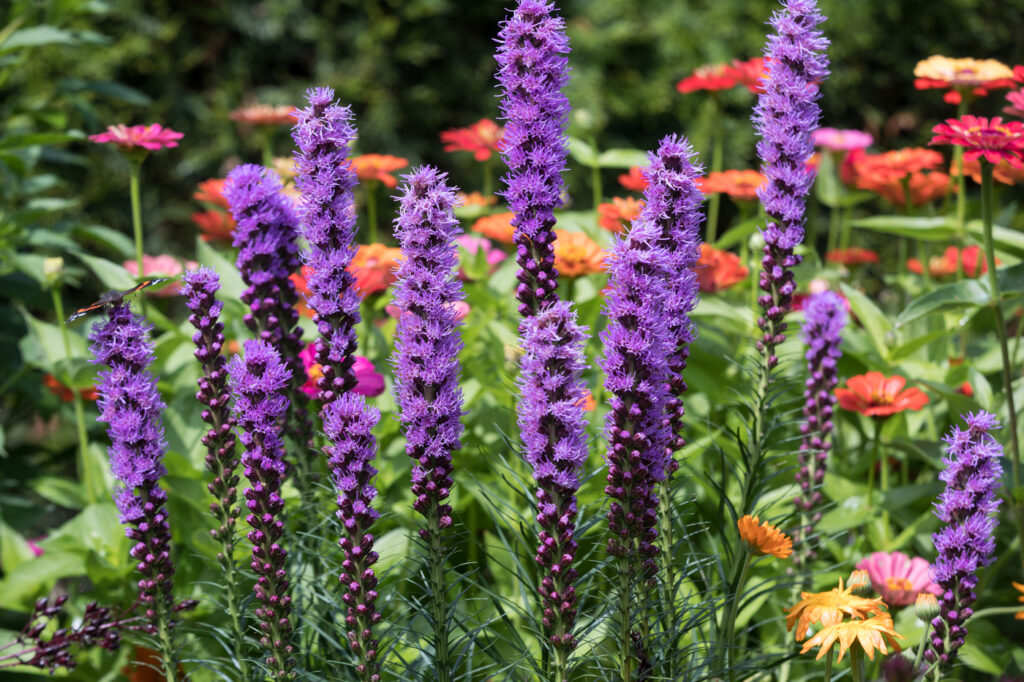
Butterflies and bees love the gayfeather’s colorful flower spires. Fortunately for us, it can tolerate hot and cold and does fine in poor soils. This plant is native to grasslands in North America. It’s drought-tolerant and has roots that can grow as far down as 14 feet!
Gazania (Gazania rigens)
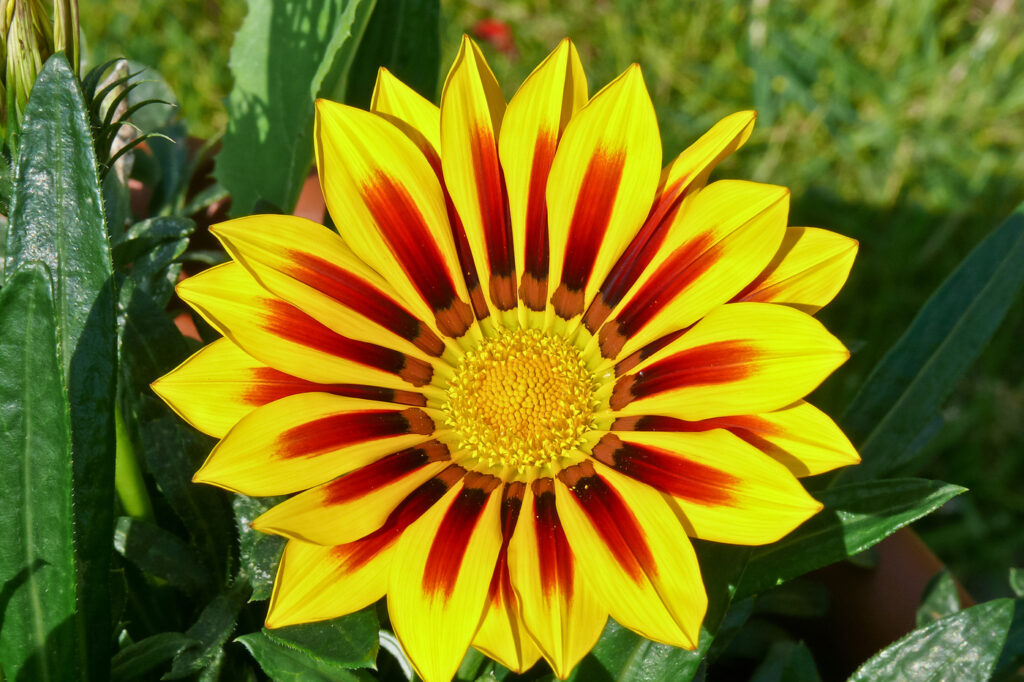
Gazania is a foot-tall perennial that can grow in Zones nine to eleven. It is native to South Africa with bright orange flowers. In fact, “Gaza” is Latin for “treasure.” These flowers are ideal for containers and cutting.
Gentian (Gentiana spp.)
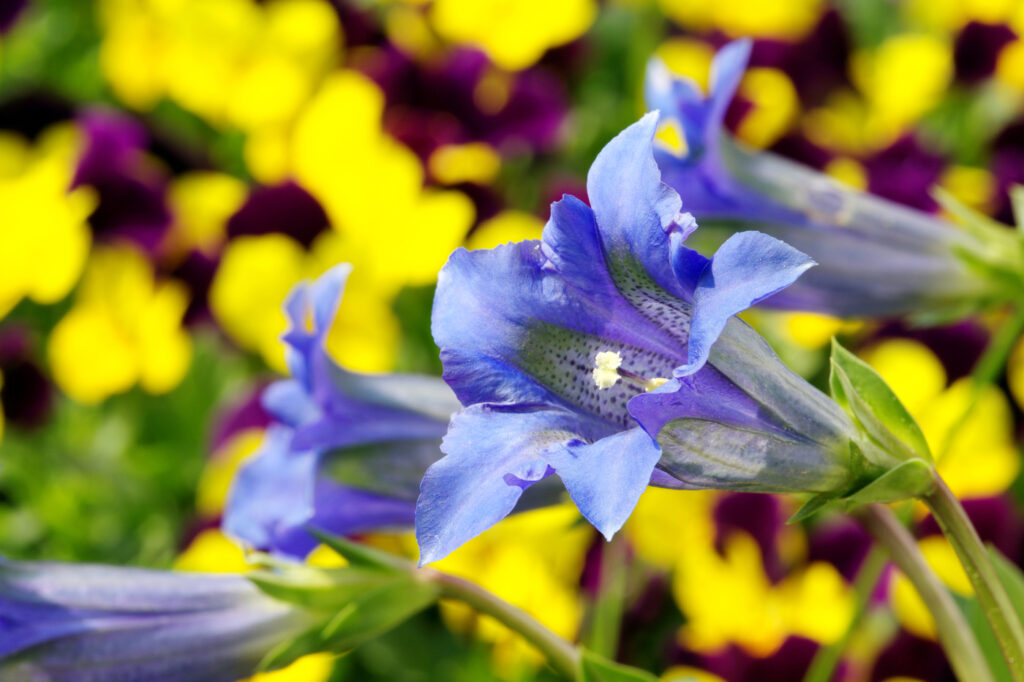
Gentian is a plant native to Europe, Asia, and North America. It’s an Alpine plant so it grows best at high altitudes. Gentian makes an ideal ground cover, as it grows up to four inches tall. It prefers shaded conditions and can grow up to Zone seven.
Geranium maculatum (Wild geranium)
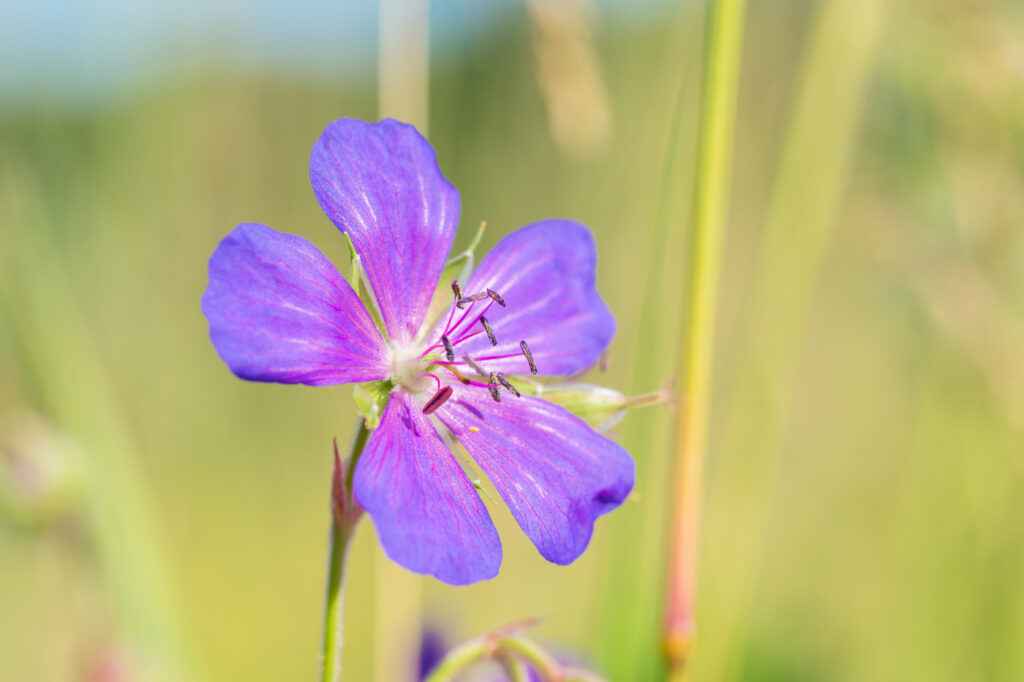
Unlike the false geranium, this geranium is a perennial that thrives in Zones three to seven. It’s native to North American woodlands with white, red, blue, purple, and pink flowers. It blooms all summer and attracts beneficial insects.
Germander (Teucrium spp.)
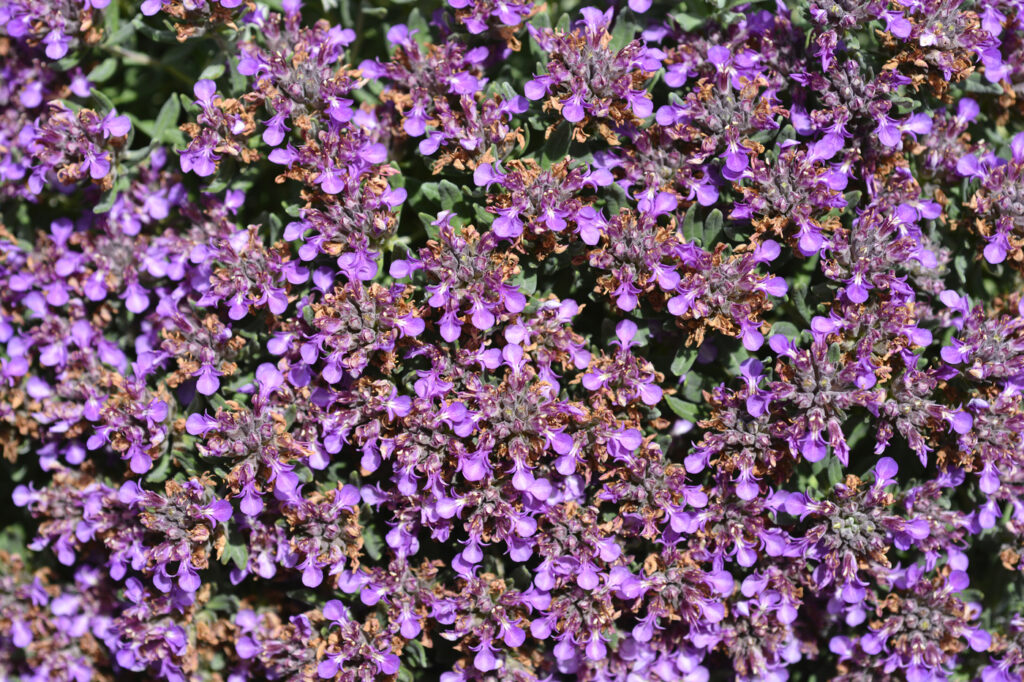
The germander is part of the mint family and is native to the Mediterranean. This shrub can reach towering heights of 8 feet. It’s drought-tolerant and does well in rocky or sandy soils. In Zones five to nine, it will return year after year. This is one of the tinier and delicate flowers that begin with G.
Geum spp. (Avens)
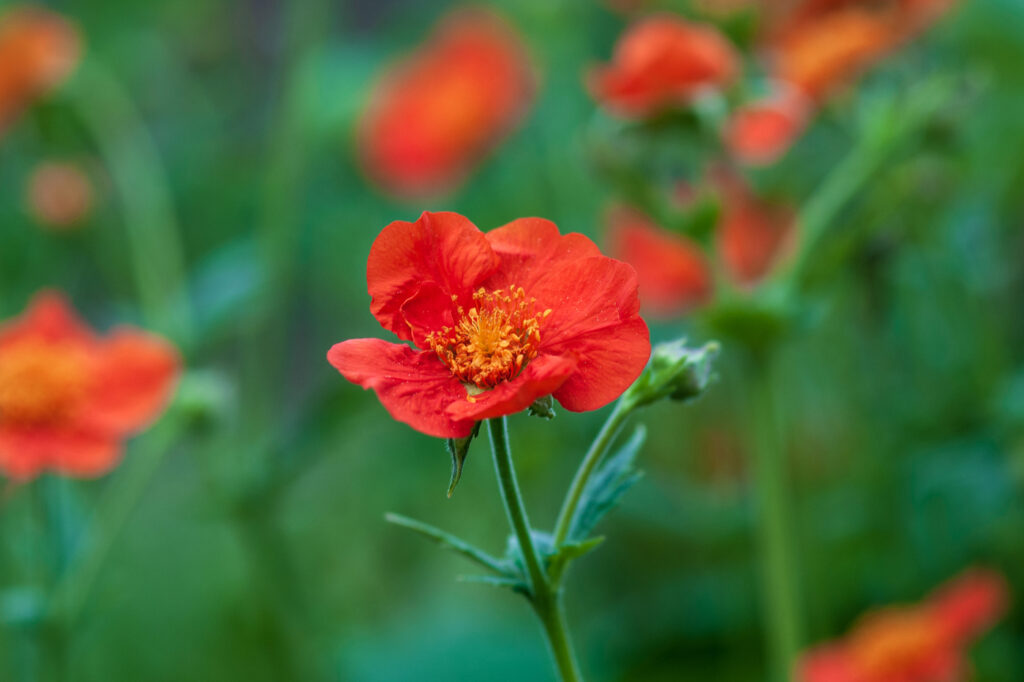
Not often found in nurseries or seed catalogs, Geum is one of the rarest flowers that start with the letter G. It prefers cooler climates and grows in Zones five to seven in part shade conditions.
With proper care, it can bloom from spring through the end of summer. To remain vigorous, Geum needs to be divided yearly.
Giant barrel cactus (Echinocactus platyacanthus)
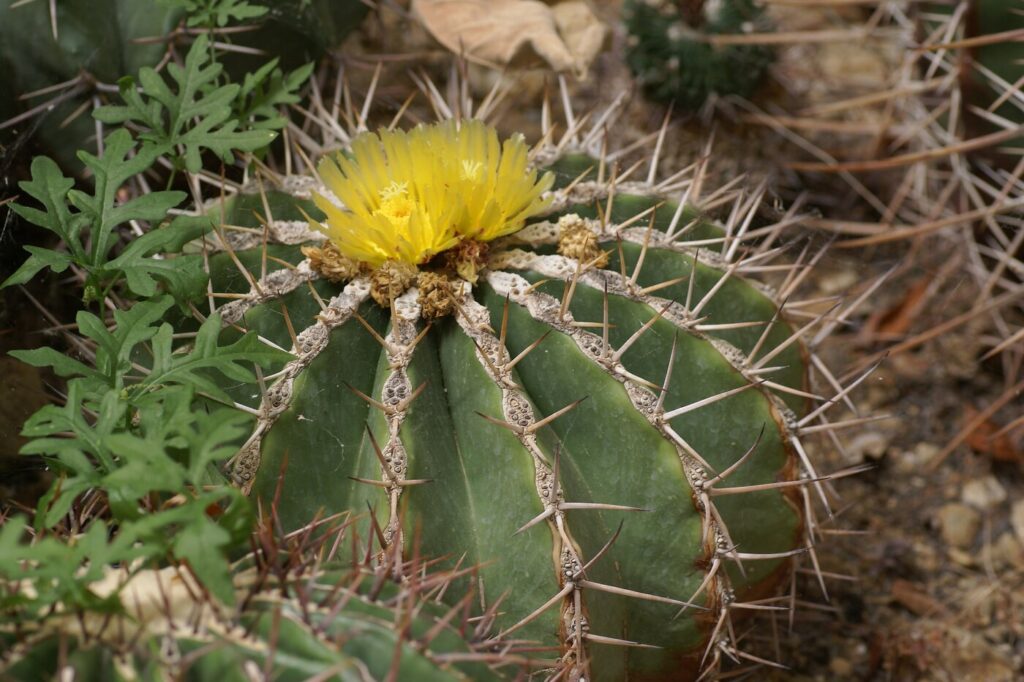
The giant barrel cactus is the only succulent on the list! While it grows slowly, it can reach heights of over eight feet. When it blooms, it shows off its bright yellow flowers. It is a perennial in desert climates but can be grown in conservatories of any climate.
Giant fleece flower (Persicaria polymorpha)
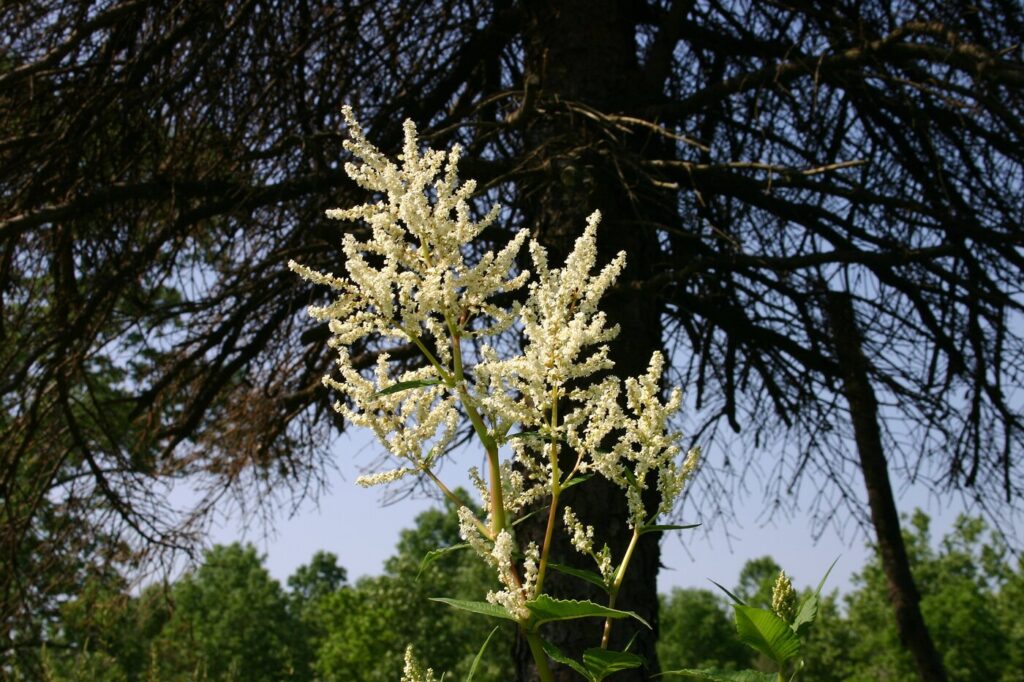
Giant fleece flowers can grow up to five feet tall and five feet wide. They are pollinator-friendly and bloom summer-long. This Asia native is most known for its striking, white flowers.
Giant hyssop (Agastache spp.)
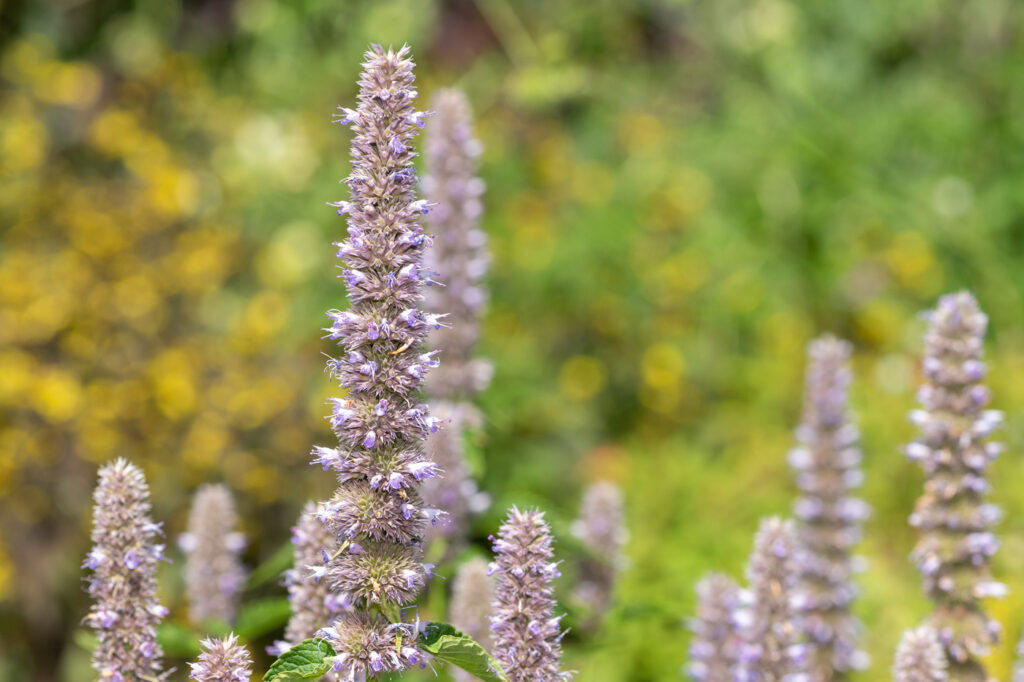
Another member of the mint family, the giant hyssop is native to North America. It’s a perennial from Zones five to ten. Also much-loved by pollinators, it bears spikes of purple, pink, or white flowers. Truly a giant, it can grow up to six feet tall!
Gladiolus (Gladiolus palustris)
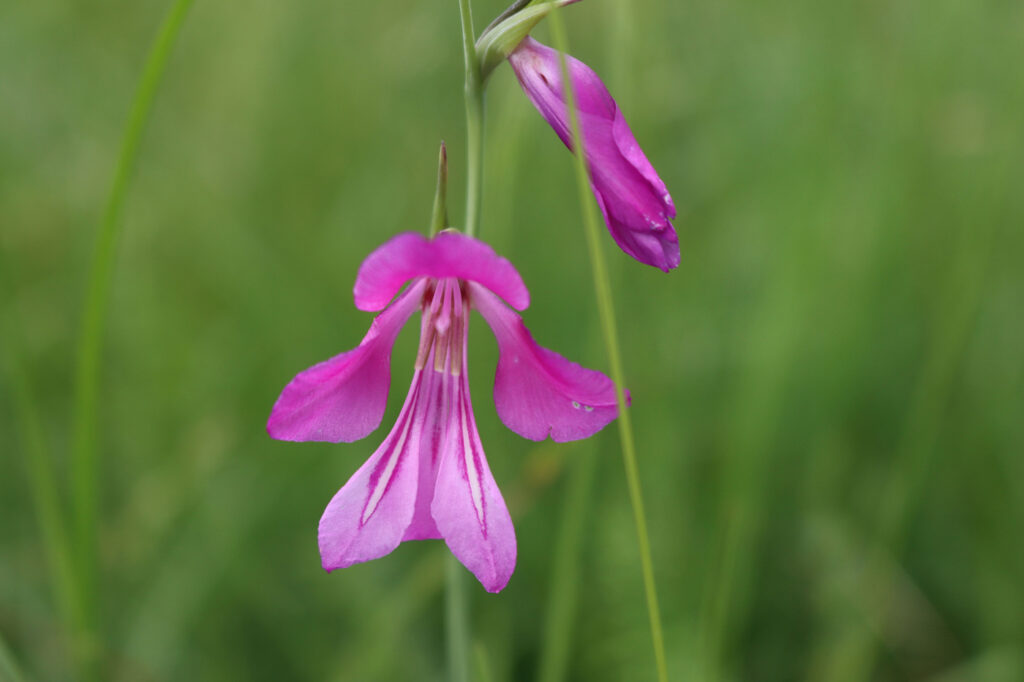
Gladiolus is a well-known corm with more than three hundred species. It’s native to Europe, Africa, and the Mediterranean. Its tall flower spikes come in a variety of colors and are ideal for flower arrangements.
Globeflower (Trollius spp.)
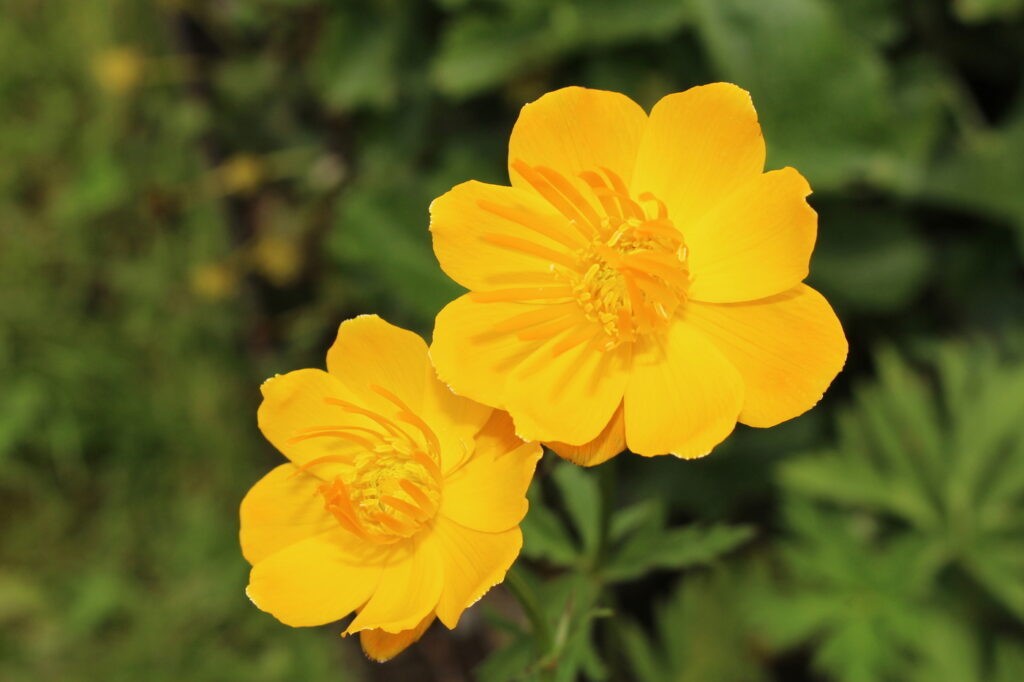
The rare globeflower stands out from the crowd with yellow and orange flowers. While it’s native to northern Europe, it can thrive in U.S. Zones three to eight. It does best in somewhat damp conditions and prefers cooler climates. It’s often found in meadows and swamps.
Globe thistle (Echinops spp.)
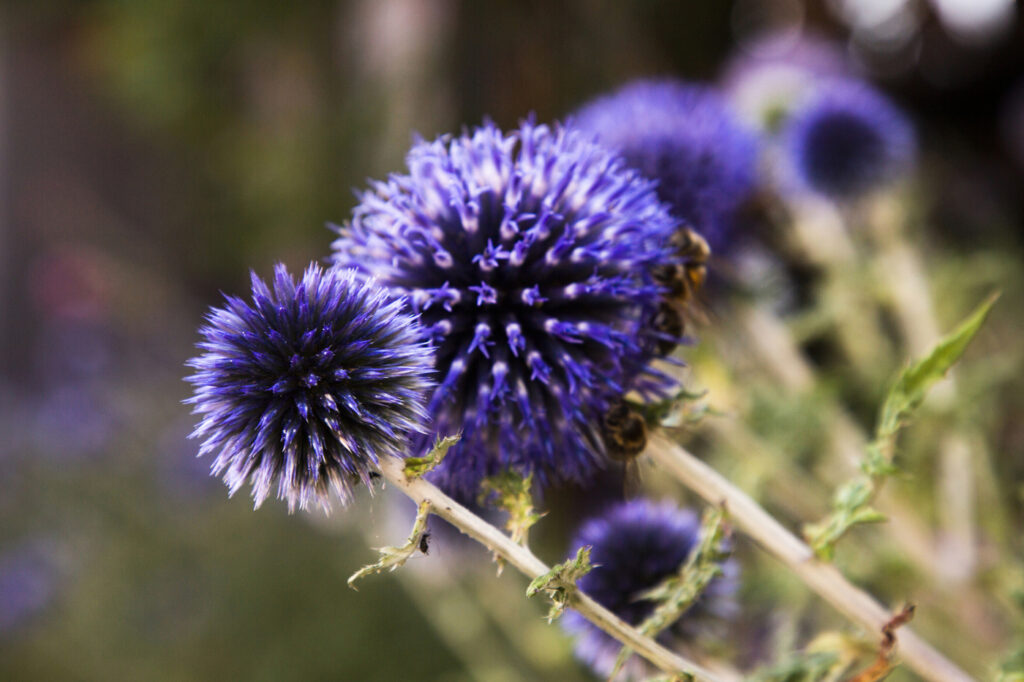
The globe thistle is a Dr. Seuss-like perennial from the Mediterranean. It will grow in Zones two to eight in full sun and free-draining soil. Its blue, spikey globe flowers seed freely after blooming. Some varieties can grow to be four feet tall.
Goatsbeard (Aruncus spp.)
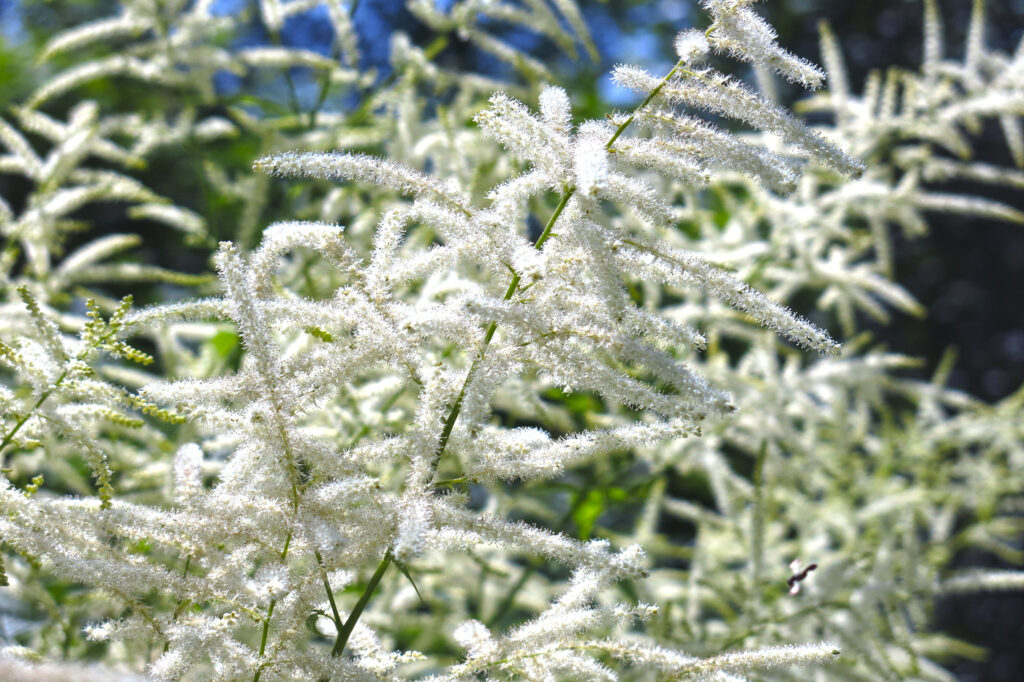
It’s no surprise where this flower got its name! Its white, spiky blossoms resemble a goat’s beard. It grows in Zones three to eight and is native to North America. While it’s only in bloom for 10 days, it makes for a lovely cut flower, making it one of the special flowers that start with G.
Godetia (Clarkia amoena)
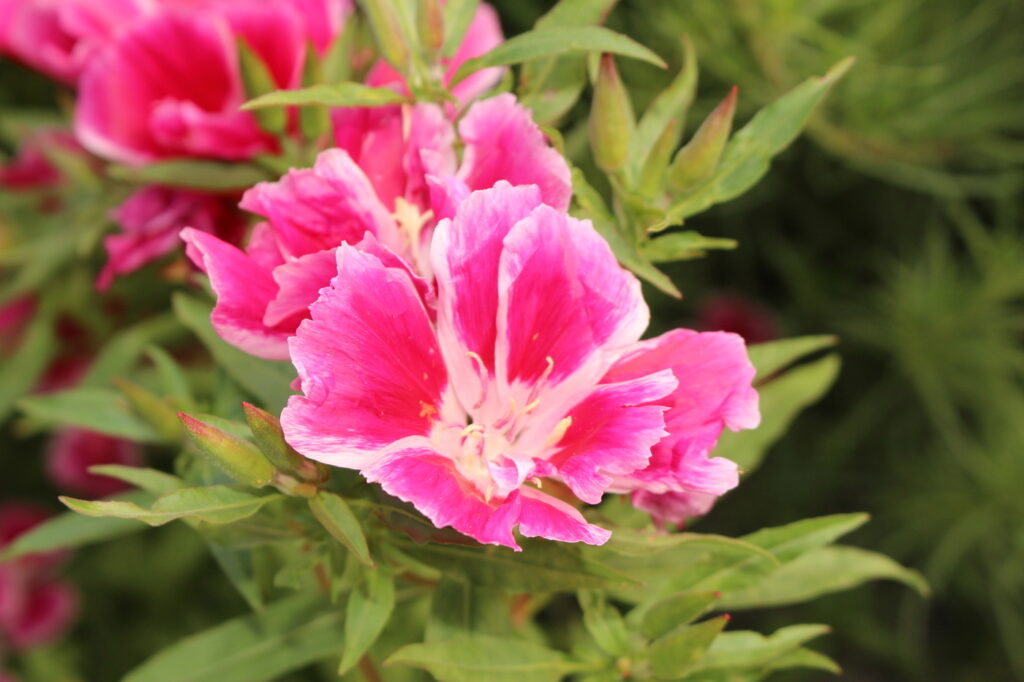
This fast-growing plant grows up to two feet tall and can be planted in Zones three to eleven. The godetia is one of the most beautiful prairie wildflowers native to North America. It grows best in full sun to partial shade.
Golden groundsel (Senecio aureus)
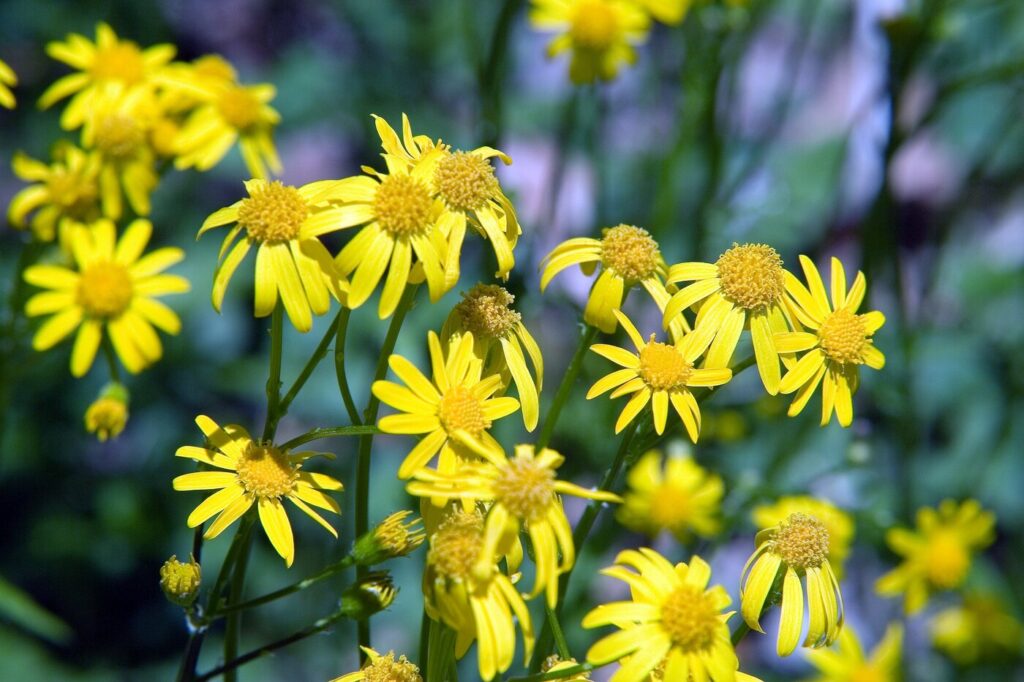
The golden groundsel is mostly grown as a ground cover. It does especially well in wetter parts of the garden or in moist soils. Another U.S. plant, the golden groundsel is native to eastern North America. It spreads by rhizome, so if you plant it, make sure it doesn’t take over!
Goldenrod (Solidago spp.)
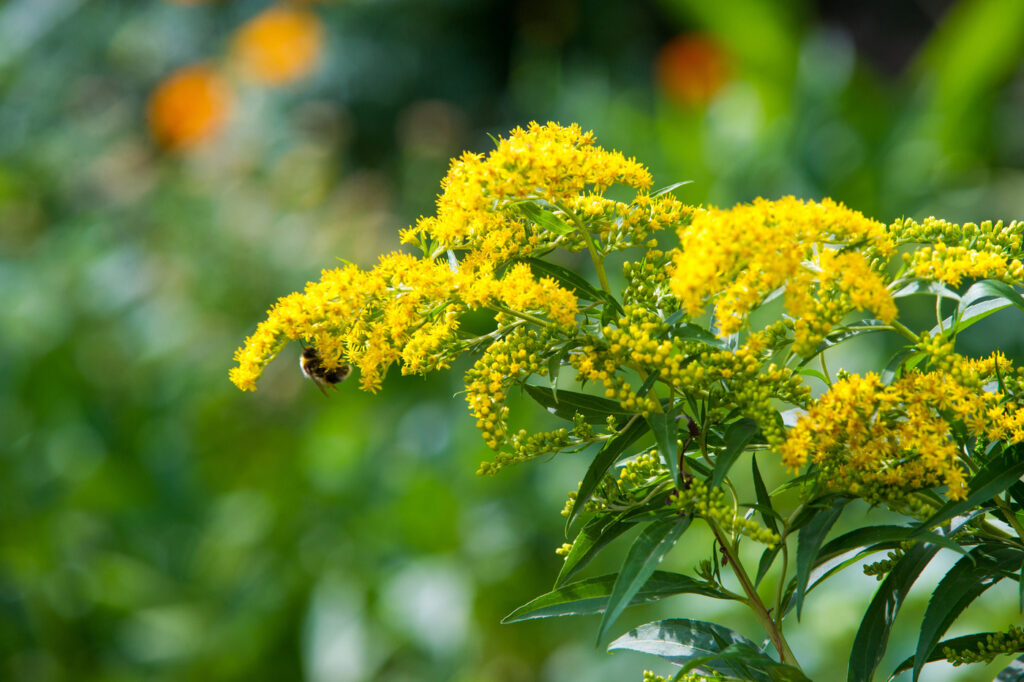
This quintessential North American native has over one hundred species. It’s easily propagated by rhizome or self-seeding. It’s both deer-resistant and pollinator friendly. Best of all, it has clusters of yellow flowers that look like bursting fireworks.
Gooseneck loosestrife (Lysimachia clethroides)
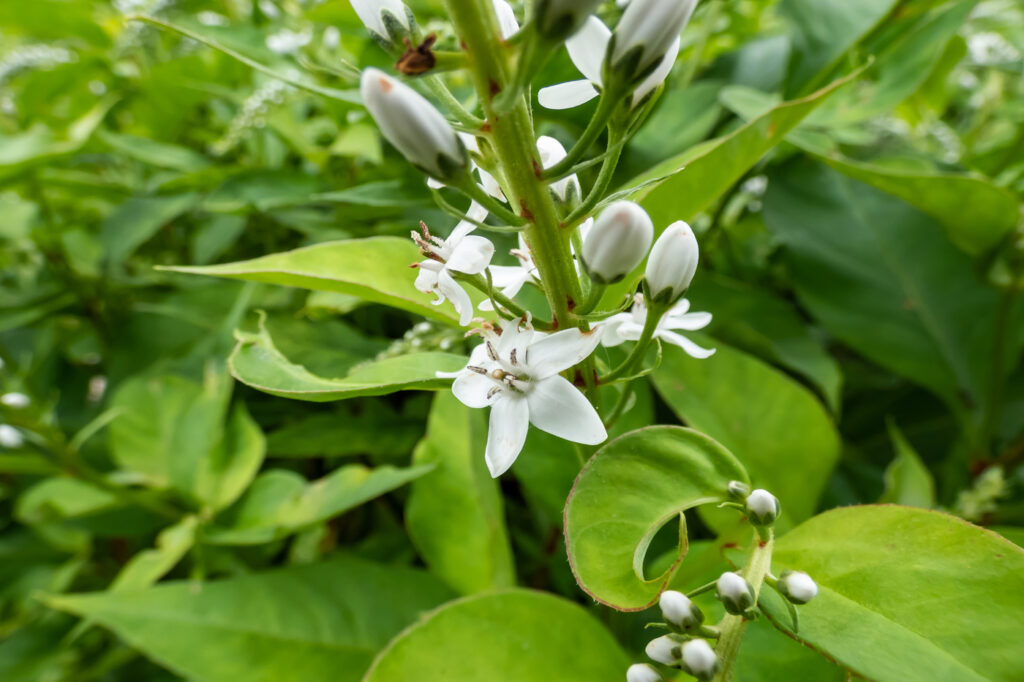
While the gooseneck loosestrife is a showy architectural plant, it is invasive in North America. This native to China and Japan is a fast-growing perennial that spreads by rhizome. It’s typically grown for flower arranging. Its tall white flowers resemble goosenecks, hence the name.
Grape hyacinth (Muscari armeniacum)
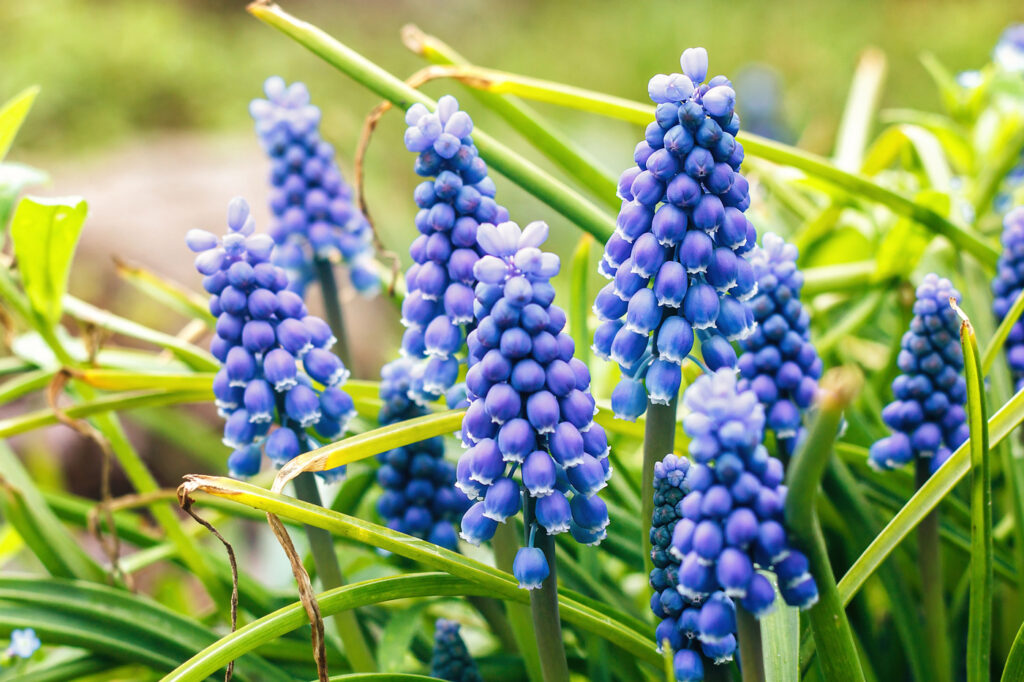
The bright purple blooms of the grape hyacinth arrive in spring. It is not actually from the hyacinth family, but is a bulb from the asparagus family. They’re native to Asia and perennial in Zones four to eight. As their name indicates, their bright purple flowers resemble tiny grapes.
Gumamela (Hibiscus rosa-sinensis)
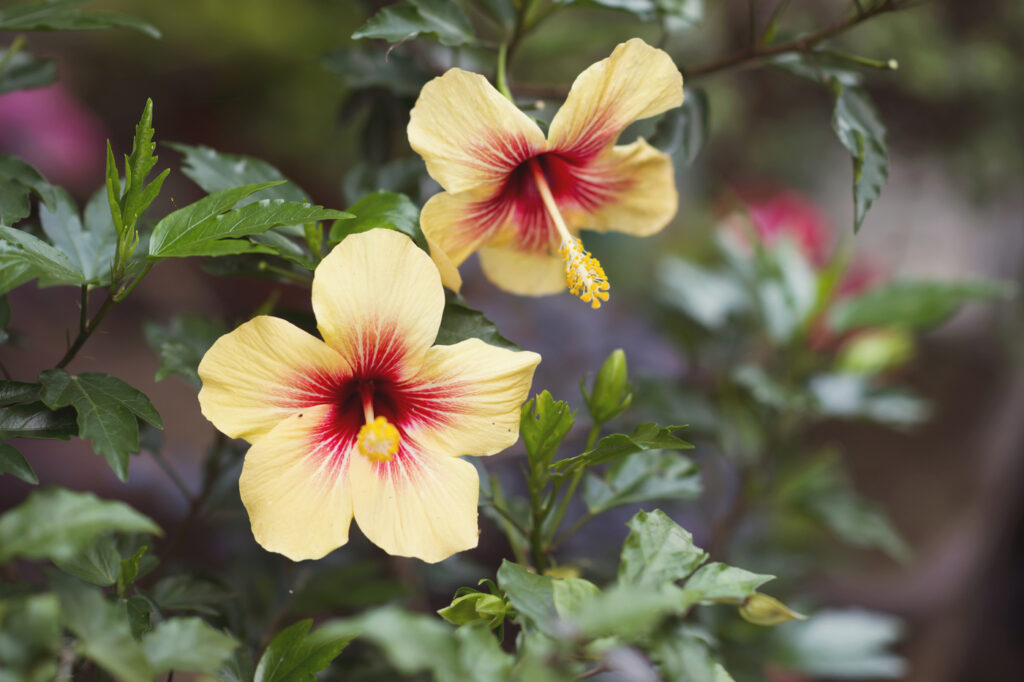
Some Eastern societies praise Guatemala for its medicinal uses. Exotic-looking flowers come in bright shades of red, pink, orange, purple, yellow, and white. They can only grow in warmer climates and do best in Zones nine to eleven.
Frequently Asked Questions (FAQ) Flowers that Begin with G
What are some names of exotic flowers that start with G?
The gumamela or hibiscus is the most exotic flower on the list because of its tropical blooms. It can only grow in U.S. Zones nine to eleven.
What are the most popular flowers that start with G?
Many gardeners have planted at least one or even several of these plants! Some of the most popular flowers that start with G are gloxinia, gardenia, geranium, globe thistle, Galanthus nivalis, and gypsophila.
Are there any morning flowers that start with G?
There are no flowers that start with G that only bloom only in the morning. Most of the flowers open in the morning and bloom throughout the day.
Which shade flowers that start with G grow well?
For gardens with low light, these four plants that do well in shade are perfect for you! They are, gentian, golden groundsel, Geum, and godetia.
Are there any bulb flowers that start with G?
Both the grape hyacinth and Galanthus nivalis are bulb flowers that bloom in spring. The gladiolus is a corm but is often mistaken for a bulb.
What flowers that start with G are good in flower arrangements?
Most talented florists and flower arrangers could use any flowers on this list in their designs. However, the flowers that florists favor are:
Gazania
Gerbera daisy
Gooseneck loosestrife
Goatsbeard
Globe thistle
Gypsophila
What tall flowers that start with G can be planted?
Globe thistle reaches four feet. The giant fleece flower can grow up to five feet and the giant hyssop can reach six feet. And both the giant barrel cactus and germander can grow to be eight feet tall.
Are there any spring flowers that start with G?
The flowers known to bloom in spring include geraniums, grape hyacinth, golden groundsel, Galanthus nivalis, and Geum.
Here’s a side note: these flowers also thrive in cooler climates!
Are there any red flowers that start with G?
There are many varieties of plants on this list that have red flowers. The most notable plants with red flowers are geraniums, gladiolus, gaillardia, and gumamela.
Which white flowers that start with the letter G are on this list?
White is one of the most common colors for flowers on the list. White “g” flowers include: gardenia, gloxinia, gooseneck loosestrife, giant fleece flower, goatsbeard, gas plant, Gaura lindheimeri, and gypsophila.
What are some summer flowers that start with G?
Most flowers bloom in summer, but few bloom all summer. Summer-long bloomers include geraniums, gerbera daisies, Gaura lindheimeri, globe amaranth, giant fleece flower
Are there any pink flowers that start with G?
Few gardens would be complete without pretty, pink flowers. Some beautiful ones are geraniums, gloxinia, Gaura lindheimeri, globe amaranth, gumamela, and gypsophila.
Up Next
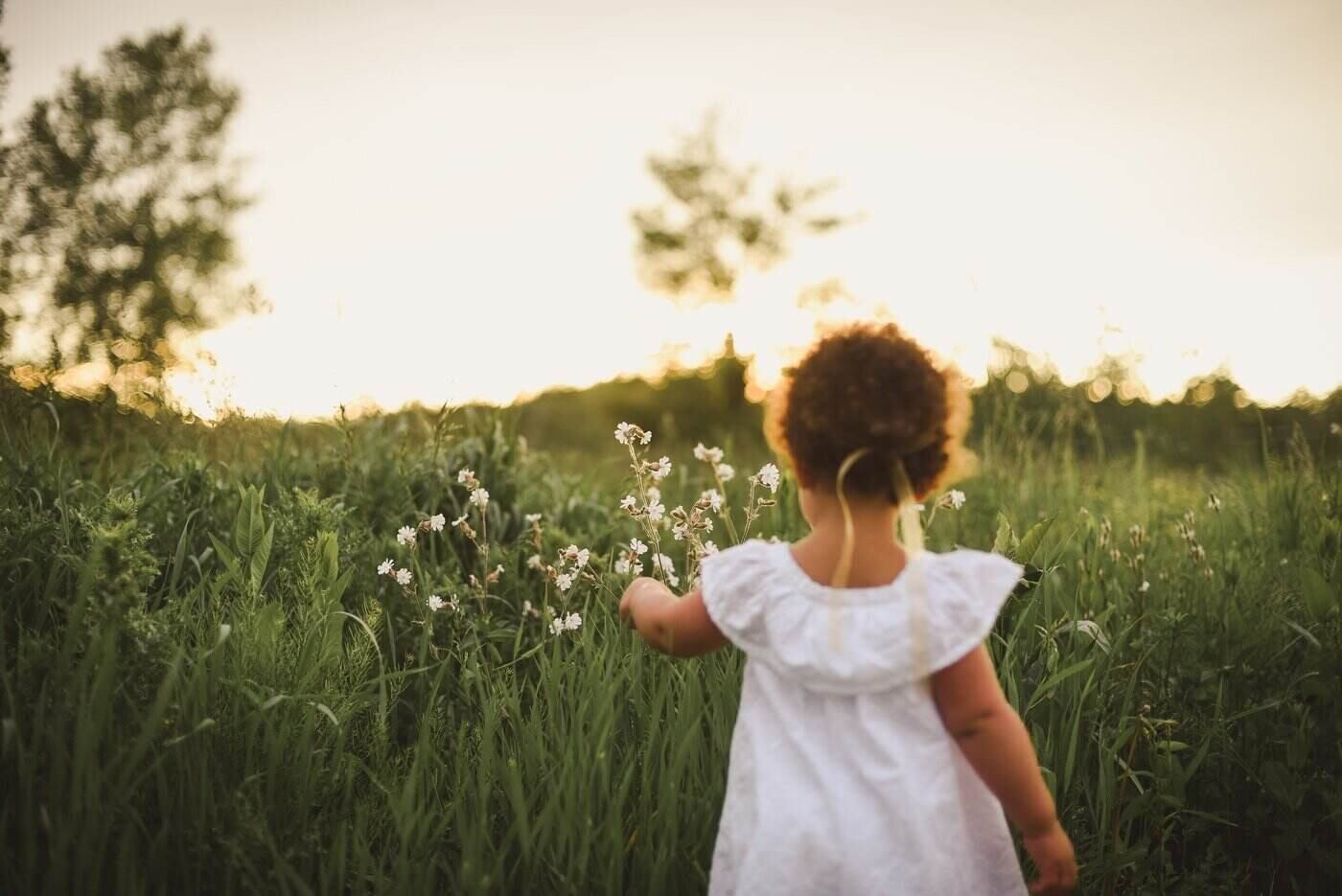
Want to make learning fun for your kid? Here’s a guide on teaching them the alphabet through flowers!
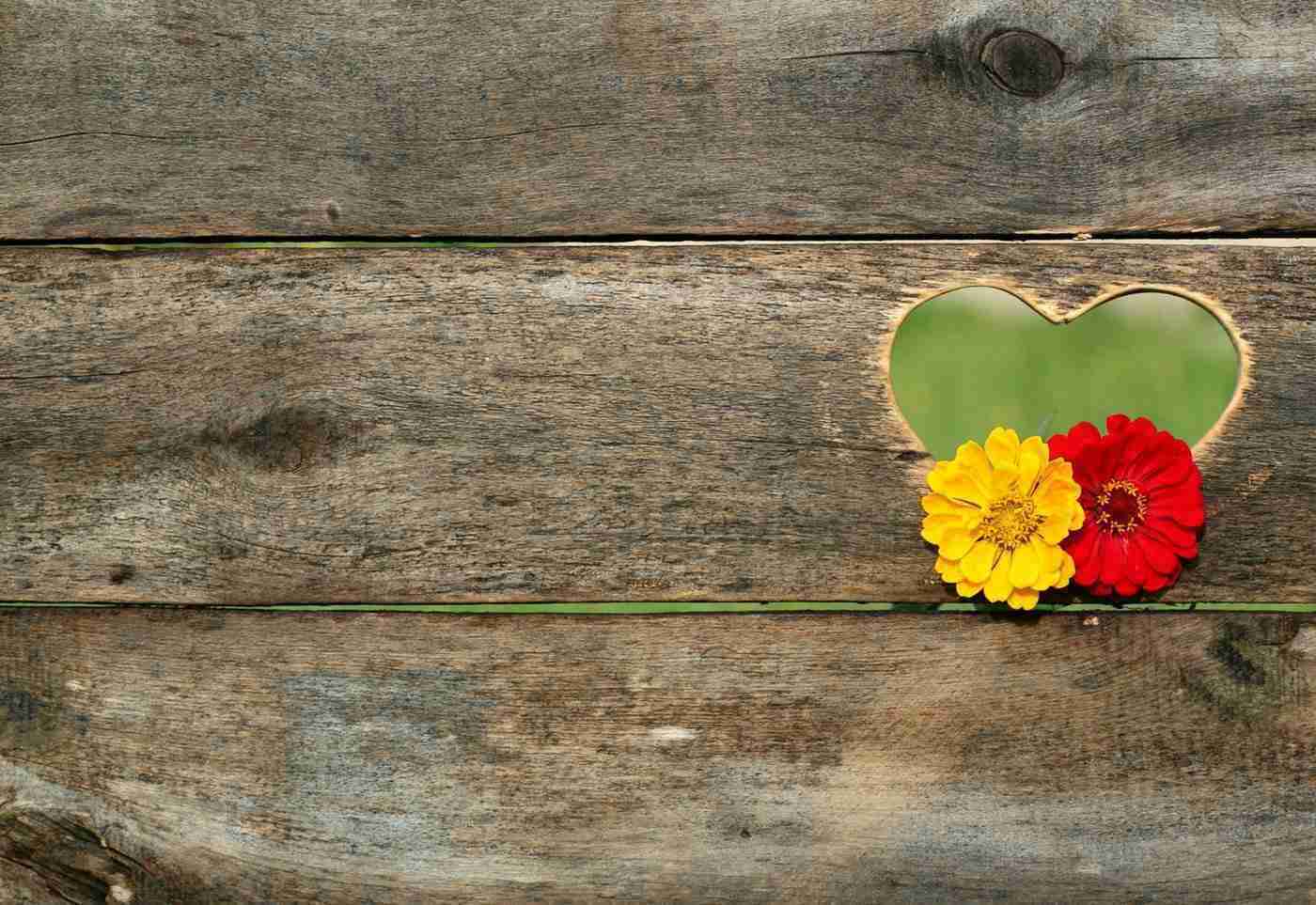
Interested in learning more about alphabetical flowers or buying a floral arrangement? Check out this handy buying guide of flowers from A-Z
Feature image: jochenschneider; Image 1: vvoennyy; Image 2: Noppharat_th; Image 3: nahhan; Image 4: M_photographer; Image 5: missisya; Image 6: DedMityay; Image 7: mszucs; Image 8: ms_pics_and_more; Image 9: olko1975; Image 10: Praiwun; Image 11: wjarek; Image 12: anjonik; Image 13: jura13; Image 14: Skaldis; Image 15: nahhan; Image 16: NadyaSo; Image 17: Ettrig; Image 18: User:SB_Johnny; Image 19: tommeaker26@gmail.com; Image 20: SaraTM; Image 21: RukiMedia; Image 22: agiwron@gmail.com; Image 23: Lumatiss; Image 24: RukiMedia; Image 25: David J. Stang; Image 26: ekina1; Image 27: Kris.Rad; Image 28: bozhena.melnyk; Image 29: Ansonde
